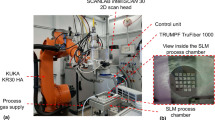Abstracts
In an effort to optimize the manufacture of near fully dense metal parts, we have developed a sub-sector scan mode for selective laser melting (SLM) technology. The working process of such a scan mode is realized by the way that the contour polygons of a three-dimensional (3D) metal part obtained by slicing layer by layer are enclosed in a small quadrangle box, specifically an encasing box, and sub-boxes (sub-sectors) in square are then divided by the enclosed quadrangle box with short scan lengths on each side. Then these sub-sectors are hatched with bidirectional scanning lines which are normal with right-angles in adjacent sectors. The algorithm is presented in this paper. In the SLM processes, this scan pattern helps to increase the temperature in small sub-sectors and melt metal powder more effectively. Parts with complex structures from stainless steel 316 L were manufactured with this new scan mode.
Similar content being viewed by others
References
Shi Y, Zhang W, Cheng Y, Huang S (2007) Compound scan mode developed from subarea and contour scan mode for selective laser sintering. Int J Mach Tools Manuf, doi:10.1016/j.ijmachtools.2006.08.013
Shi Y, Zhong Q, Chen X, Huang S, Zhou Z (2002) Research and implement of a new kind of scanning mode for selective laser sintering. Chin J Mech Eng 38(2):35–39
Ren N, Ma T, Gao C, Cai L (2003) Study on subarea scanning path based on SLS. China Mech Eng 14(16):1371–3137
Beal VE, Erasenthiran P, Hopkinson N, Dickens P, Ahrens C H (2006) The effect of scanning strategy on laser fusion of functionally graded H13/Cu materials. Int J Adv Manuf Technol, doi:10.1007/s00170-005-0130-x
Wu W, Yang Y, Huang Y (2007) Direct manufacturing of Cu-based alloy parts by selective laser melting. Chinese Optics Letters 5(1):37–40
Kruth JP, Froyen L, Van Vaerenbergh J, Mercelis P, Rombouts M, Lauwers B (2004) Selective laser melting of iron-based powder. J Mater Process Technol, doi:10.1016/j.jmatprotec.2003.11.051
Mercelis P, Kruth J P (2006) Residual stresses in selective laser sintering and selective laser melting. Rapid Prototyping J, doi:10.1108/13552540610707013
Morgan RH, Papworth AJ, Sutcliffe C, Fox P, O'Neill W (2002) High density net shape components by direct laser re-melting of single-phase powders. J Mater Sci, doi:10.1023/A:1016185606642
Subramanian K, Vail N, Barlow J, Marcus H (1995) Selective laser sintering of alumina with polymer binders. Rapid Prototyping J 1(2):24–35 doi:10.1108/13552549510086844
Huang YM, Jiang CP (2003) Curl distortion analysis during photopolymerisation of stereolithography using dynamic finite element method. Int J Adv Manuf Technol, doi:10.1007/s00170-002-1317-z
Huang YM, Kuriyama S, Jiang CP (2004) Fundamental study and theoretical analysis in a constrained-surface stereolithography system. Int J Adv Manuf Technol, doi:10.1007/s00170-003-1627-9
Hang YM, Lan HY (2006) Path planning effect for the accuracy of rapid prototyping system. Int J Adv Manuf Technol, doi:10.1007/s00170-005-0085-y
Hang YM, Lan HY (2006) Compensation of distortion in the bottom exposure of stereolithography process. Int J Adv Manuf Technol, doi:10.1007/s00170-004-2313-2
Liu Z, Bin H, Zhang X, Gao H (1998) Influence of the fractal scanning path on the temperature field of the layer in material increase manufacturing. Journal of Huazhong University of Science and Technology 26(8):32–34
Yang J, Bin H, Zhang X, Liu Z (2003) Fractal scanning path generation and control system for selective laser sintering (SLS). Int J Mach Tools Manuf, doi:10.1016/S0890-6955(02)00212-2
Wang X, Du Y, Liu H (2006) Spiral scanning-path scheme based on multi-connected Voronoi diagram. Transactions of the Chinese Society of Agricultural Machinery 37(6):134–137
Yang J, Bin HZ, Zhang XB (2002) Research on fractal-scanning path for arbitrary boundary layer in layered manufacturing. J Shanghai Univ 6(4):337–341 doi:10.1007/s11741-002-0061-9
Huang SJ, Shen WC (2005) Development of a multi-optical source rapid prototyping system. Int J Adv Manuf Technol, doi:10.1007/s00170-004-2151-2
Author information
Authors and Affiliations
Corresponding authors
Rights and permissions
About this article
Cite this article
Zhang, W., Shi, Y., Liu, B. et al. Consecutive sub-sector scan mode with adjustable scan lengths for selective laser melting technology. Int J Adv Manuf Technol 41, 706–713 (2009). https://doi.org/10.1007/s00170-008-1527-0
Received:
Accepted:
Published:
Issue Date:
DOI: https://doi.org/10.1007/s00170-008-1527-0




